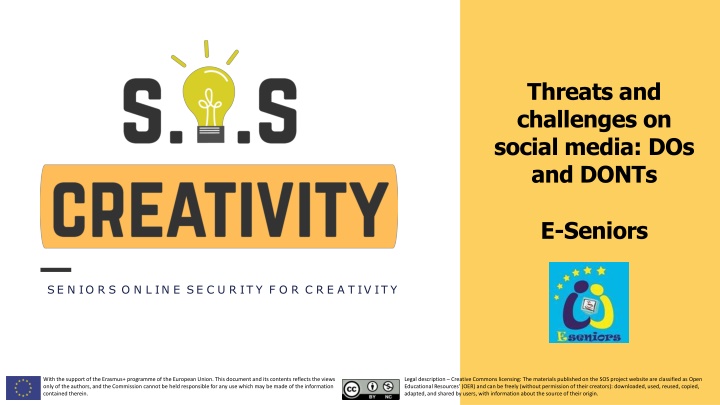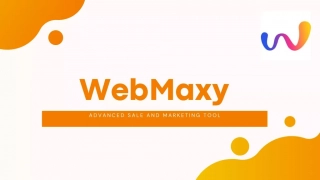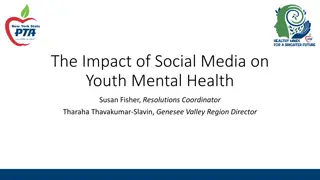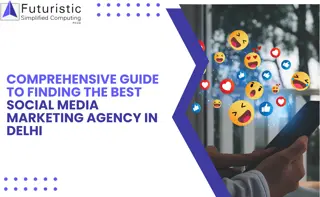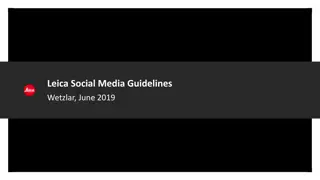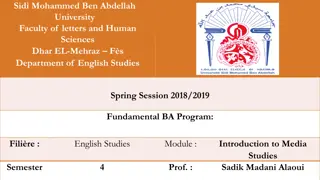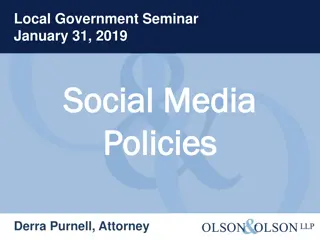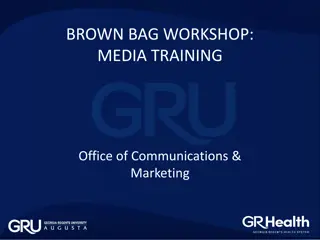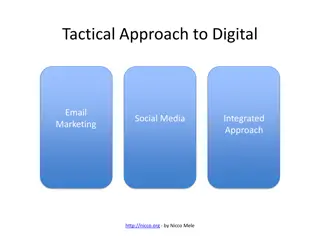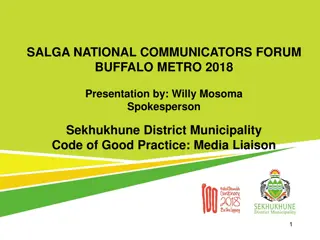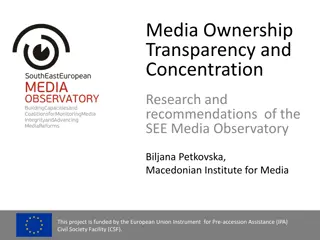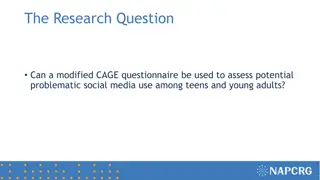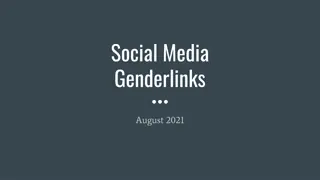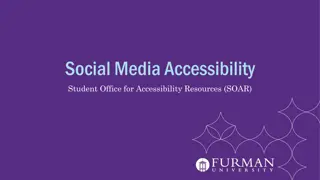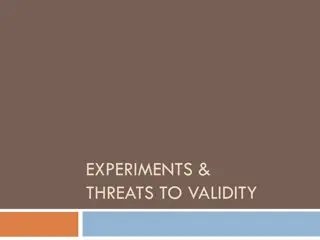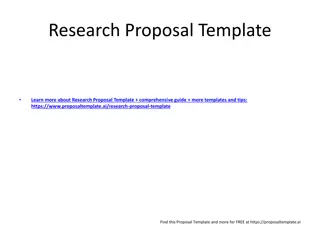Social Media Threats and Safety Tips
In the online world, staying safe on social media is crucial. Learn about common threats like phishing, malware, cyberbullying, and hate speech. Discover practical tips to protect yourself and your personal information. Stay informed and secure in your online interactions.
Download Presentation

Please find below an Image/Link to download the presentation.
The content on the website is provided AS IS for your information and personal use only. It may not be sold, licensed, or shared on other websites without obtaining consent from the author.If you encounter any issues during the download, it is possible that the publisher has removed the file from their server.
You are allowed to download the files provided on this website for personal or commercial use, subject to the condition that they are used lawfully. All files are the property of their respective owners.
The content on the website is provided AS IS for your information and personal use only. It may not be sold, licensed, or shared on other websites without obtaining consent from the author.
E N D
Presentation Transcript
Threats and challenges on social media: DOs and DONTs E-Seniors S E N IO R S O N L IN E S E C U R IT Y F O R C R E A T IV IT Y With the support of the Erasmus+ programme of the European Union. This document and its contents reflects the views only of the authors, and the Commission cannot be held responsible for any use which may be made of the information contained therein. Legal description Creative Commons licensing: The materials published on the SOS project website are classified as Open Educational Resources' (OER) and can be freely (without permission of their creators): downloaded, used, reused, copied, adapted, and shared by users, with information about the source of their origin.
1 . Objectives&Goals At the end of this module you will be able to: Identify threats that may manifest through the use of social media Knowing what to do when we face one of these threats Adopt good practices to avoid encountering these threats when browsing social media With the support of the Erasmus+ programme of the European Union. This document and its contents reflects the views only of the authors, and the Commission cannot be held responsible for any use which may be made of the information contained therein. Legal description Creative Commons licensing: The materials published on the SOS project website are classified as Open Educational Resources' (OER) and can be freely (without permission of their creators): downloaded, used, reused, copied, adapted, and shared by users, with information about the source of their origin.
Unit 3.1 : Threatsand challenges Phishing: Phishing is a type of social engineering where an attacker sends a fraudulent message designed to trick a human victim. These messages are designed to trick you into revealing personal information by pretending to be from a trusted source. The messages may come from people claiming to be a friend of yours or a known company. Never share confidential information and never click on a suspicious-looking web link. Psychological hacking: Psychological hacking is the process of obtaining confidential information from a person through trickery. The fraudster may start a conversation about things they read on your profile, such as where you work, etc. They then try to get you to reveal personal information, similar to phishing. Malware: Malware is malicious software designed to infiltrate devices. It circulates on social networks as links with catchy titles. Once the malware is infiltrated, it can send messages to contacts, access personal information, or damage the device. Caution should be exercised when tempted to click on a link from an unknown source. Hate speech: Hate speech is common on social networks because its authors can remain anonymous. It can happen that you receive hate speech, sometimes without any network, so it is important to detach yourself from it and not hesitate to report it as unwanted and malicious content. Cyberbullying: is bullying that takes place over digital devices like cell phones, computers, and tablets. Cyberbullying can occur through SMS, Text, and apps, or online in social media, forums, or gaming where people can view, participate in, or share content. Cyberbullying includes sending, posting, or sharing negative, harmful, false, or mean content about someone else. It can include sharing personal or private information about someone else causing embarrassment or humiliation. Some cyberbullying crosses the line into unlawful or criminal behavior. Ageism online: Ageism refers to the stereotypes (how we think), prejudice (how we feel) and discrimination (how we act) towards others or oneself based on age. Ageism affects everyone. Children as young as 4 years old become aware of their culture s age stereotypes. From that age onwards they internalize and use these stereotypes to guide their feelings and behavior towards people of different ages. They also draw on culture s age stereotypes to perceive and understand themselves, which can result in self-directed ageism at any age. Ageism intersects and exacerbates other forms of disadvantage including those related to sex, race and disability. With the support of the Erasmus+ programme of the European Union. This document and its contents reflects the views only of the authors, and the Commission cannot be held responsible for any use which may be made of the information contained therein. Legal description Creative Commons licensing: The materials published on the SOS project website are classified as Open Educational Resources' (OER) and can be freely (without permission of their creators): downloaded, used, reused, copied, adapted, and shared by users, with information about the source of their origin.
Unit 3.1 : Threatsand challenges What to watch out for to avoid Facebook Scams: People you don't know personally asking you for money or your bank details. Unverified Pages claiming to represent a large organization or public figure. People who ask you to continue your conversation outside of Facebook, in a less public or less secure setting, such as a separate email address. People asking you to send them your bank details in order to receive a reward. Anyone claiming to be a friend or relative of yours in distress. People who lie about where they live. Posts or publications containing spelling mistakes and grammatical errors. People or accounts that redirect you to a Page to claim a prize With the support of the Erasmus+ programme of the European Union. This document and its contents reflects the views only of the authors, and the Commission cannot be held responsible for any use which may be made of the information contained therein. Legal description Creative Commons licensing: The materials published on the SOS project website are classified as Open Educational Resources' (OER) and can be freely (without permission of their creators): downloaded, used, reused, copied, adapted, and shared by users, with information about the source of their origin.
Unit 3.2: 10 good practices to adopt for security on social network 1. Protect access to your accounts: Use strong passwords that are different from one account to another. Password manager applications can help you to easily save your passwords. For example https://keepassxc.org/ 2. Check your privacy settings: By default, the privacy settings are often open (on personal information such as name, phone number, email address). This data can be accessible to all subscribers of the social network. It is possible to limit this visibility by adjusting the account configuration to keep control of what other users see. 3. Control your posts: Your posts can get out of hand and be reposted or interpreted more than you intended. Do not post personal or sensitive information. 4. Be careful who you talk to, Your friends may be sharing malicious content without knowing it, or may have been hacked themselves. Never send money without verifying the person's identity, don't send private videos, be suspicious of contests, unexpected winnings, or "great deals" that may hide scams. 5. Control third-party applications: Some applications offer to interact with one of your social network accounts. They require permissions that need to be examined carefully, as some of them may then have access to your data. Be careful not to install applications that you suspect of being malicious. With the support of the Erasmus+ programme of the European Union. This document and its contents reflects the views only of the authors, and the Commission cannot be held responsible for any use which may be made of the information contained therein. Legal description Creative Commons licensing: The materials published on the SOS project website are classified as Open Educational Resources' (OER) and can be freely (without permission of their creators): downloaded, used, reused, copied, adapted, and shared by users, with information about the source of their origin.
Unit 3.2: 10 good practices to adopt for security on social network 6. Avoid public computers and networks: Using an open-access computer or public Wi-Fi is risky as they may be compromised or under the control of cybercriminals. Avoid entering sensitive information or using them if possible. 7. Check your account logins regularly: Most social networks allow you to see active account connections or sessions. Check this information regularly to make sure that another device is not connected to one of your accounts. If it is, disconnect it and change your password. 8. Be aware of fake news: Some published information may be false, deliberately, or not. Before considering or relaying any information, check its authenticity. 9. Check your identifications with your accounts: Some websites offer to register you with your social network account. This avoids the need to create a password, for example, but may provide personal data to the site or allow a cybercriminal who has hacked your social network to access your account on that site as well. 10. Delete your account if you no longer use it: To avoid all the risks described above, to ensure that your account is not used without your knowledge, delete your account when you no longer need it. With the support of the Erasmus+ programme of the European Union. This document and its contents reflects the views only of the authors, and the Commission cannot be held responsible for any use which may be made of the information contained therein. Legal description Creative Commons licensing: The materials published on the SOS project website are classified as Open Educational Resources' (OER) and can be freely (without permission of their creators): downloaded, used, reused, copied, adapted, and shared by users, with information about the source of their origin.
Summing Up Many threats Cybercriminals Using social media involves many things, including several risks Confidentiality not always guaranteed Anonymity With the support of the Erasmus+ programme of the European Union. This document and its contents reflects the views only of the authors, and the Commission cannot be held responsible for any use which may be made of the information contained therein. Legal description Creative Commons licensing: The materials published on the SOS project website are classified as Open Educational Resources' (OER) and can be freely (without permission of their creators): downloaded, used, reused, copied, adapted, and shared by users, with information about the source of their origin.
THANK YOU! E-Seniors With the support of the Erasmus+ programme of the European Union. This document and its contents reflects the views only of the authors, and the Commission cannot be held responsible for any use which may be made of the information contained therein. Legal description Creative Commons licensing: The materials published on the SOS project website are classified as Open Educational Resources' (OER) and can be freely (without permission of their creators): downloaded, used, reused, copied, adapted, and shared by users, with information about the source of their origin.
